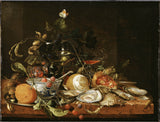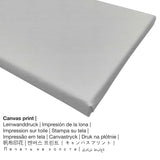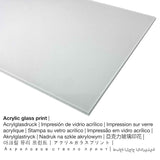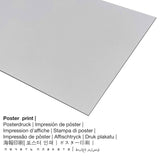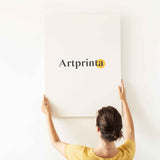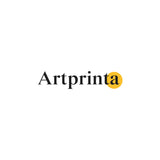Jan Davidsz. de Heem - N'agbanyeghị ndụ nwere mmanya, mkpụrụ osisi na oysters - ọmarịcha nka
Ụtụ gụnyere. Mbupu gbakọrọ na ndenye ọpụpụ.
"Still Life with Wine, Fruit and Oysters"kere site na Jan Davidsz. de Heem dị ka ihe osise gị pụrụ iche
onye omenkà Jan Davidsz. de Heem painted this piece of art. The original measures the dimensions: Ogologo: 37,7 cm (14,8 ″); Obosara: 47,4 cm (18,6 ″) Ekebere: Elu: 56 cm (22 ″); Obosara: 66 cm (25,9 ″); Omimi: 7 cm (2,7 ″). mmanụ was used by the Dutch painter as the medium of the painting. This piece of art can be viewed in in the Nationalmuseum Stockholm's collection, which is Sweden's museum of art and design, a Swedish government authority with a mandatet o preserve cultural heritage and promote art, interest in art and knowledge of art. We are delighted to reference that this masterpiece, which is part of the public domain is provided with courtesy of Nationalmuseum Stockholm na Wikimedia Commons.Ebe E Si Nweta nke ihe osise:. Ọzọkwa, itinye n'usoro mmepụta dijitalụ dị odida obodo usoro na oke nke 4: 3, nke pụtara na ogologo bụ 33% ogologo karịa obosara. The painter, botanical illustrator Jan Davidsz. de Heem was an artist from the Netherlands, whose style can primarily be assigned to Baroque. The Dutch painter lived for a total of 78 years, born in the year 1606 in Utrecht, Utrecht province, Netherlands and deceased in the year 1684.
Họrọ ụdị ngwaahịa ngwaahịa gị
The product dropdown menu gives you the opportunity to choose your favorite material and size. You can select your favorite size and material between the options:
- Mpempe akwụkwọ ederede (akwa akwa akwa): The Artprinta poster is a printed sheet of canvas with a fine surface finish. A print poster is appropriate for placing your art copy in a customized frame. Please bear in mind, that depending on the size of the canvas poster print we add a white margin of around 2-6cm around the painting to facilitate the framing with your custom frame.
- Mbipụta kanvas: A canvas direct print is a printed cotton canvas mounted on a wooden stretcher. It makes a typical impression of three dimensionality. Canvas prints are relatively low in weight, meaning that it is easy to hang up your Canvas print without any wall-mounts. Canvas prints are suited for all types of walls.
- Mbipụta iko acrylic (nke nwere ezigbo mkpuchi iko): A glossy acrylic glass print, which is often referred to as a fine art print on plexiglass, makes your favorite original work of art into brilliant décor and is a great alternative to canvas or aluminium dibond art prints. With an acrylic glass fine art print contrasts and also artwork details will be more identifiable due to the very subtle gradation of the picture.
- Aluminom dibond mbipụta (ọla): Aluminium Dibond prints are prints on metal with an outstanding depth. For your Direct Print On Aluminum Dibond, we print the selected artwork onto the surface of the aluminum material. The white and bright sections of the artwork shine with a silk gloss, however without the glare. The direct print on aluminium is the most popular entry-level product and is a truly modern way to showcase artworks, since it puts the viewer’s focus on the image.
Legal disclaimer: We try our best to describe the art products in as much detail as possible and to exhibit them visually on the product detail pages. Although, the pigments of the print products and the print result may vary somehwat from the image on your device's screen. Depending on your screen settings and the quality of the surface, colors may not be printed as exactly as the digital version shown here. Because the fine art prints are printed and processed manually, there might as well be slight discrepancies in the size and exact position of the motif.
Ngwaahịa a
| Bipụta ngwaahịa: | ọmarịcha nka |
| Mmeputakwa: | dijitalụ mmeputakwa |
| Produzọ mmepụta: | mbipụta dijitalụ (Mbipụta UV ozugbo) |
| Ihe ngosi: | emere na Germany |
| Stockdị ngwaahịa: | na mmepụta ihe |
| Ojiji ngwaahịa: | imewe ụlọ, ụlọ ihe osise nka |
| Nhazi nka nka: | usoro odida obodo |
| Ụdị anya: | (ogologo: obosara) 4: 3 |
| Mmetụta nke akụkụ akụkụ: | ogologo bụ 33% ogologo karịa obosara |
| Nhọrọ akụrụngwa: | ígwè ebipụta (aluminium dibond), acrylic glass print (nwere ezigbo mkpuchi iko), mbipụta akwụkwọ mmado (akwụkwọ kwaaji), akwụkwọ akwa akwa. |
| Ọdịiche dị n'okirikiri akwa akwa akwa (akwa akwa): | 40x30cm - 16x12", 80x60cm - 31x24", 120x90cm - 47x35", 160x120cm - 63x47" |
| Acrylic glass print (nwere ezigbo mkpuchi iko) nhọrọ: | 40x30cm - 16x12", 80x60cm - 31x24", 120x90cm - 47x35", 160x120cm - 63x47" |
| Nhọrọ nke mbipụta akwụkwọ mmado (akwụkwọ kwaaji): | 40x30cm - 16x12", 80x60cm - 31x24", 120x90cm - 47x35" |
| Mbipụta aluminom (ihe alumini debond ihe): | 40x30cm - 16x12", 80x60cm - 31x24", 120x90cm - 47x35" |
| Nhazi mbipụta nka: | enweghị etiti |
Iberibe ozi nka
| Aha nke eserese ahụ: | "Still Life with Wine, Fruit and Oysters" |
| nhazi ọkwa: | sere |
| Agba na: | mmanụ |
| Nha izizi: | Ogologo: 37,7 cm (14,8 ″); Obosara: 47,4 cm (18,6 ″) Ekebere: Elu: 56 cm (22 ″); Obosara: 66 cm (25,9 ″); Omimi: 7 cm (2,7 ″) |
| Ụlọ ihe ngosi nka: | National Museum nke Stockholm |
| Ebe ngosi nka: | Stockholm, Obodo Stockholm, Sweden |
| Weebụsaịtị ihe ngosi nka: | National Museum nke Stockholm |
| Ikikere nke ihe osise: | ngalaba ọha |
| Site n'aka: | Nationalmuseum Stockholm na Wikimedia Commons |
Onye na-ese ihe
| Aha onye nka: | Jan Davidsz. de Heem |
| Aliases: | Heem Jan Davidsz de, J. D. D. Oude de Heem, de heem david, Jan Davidsz. Deheme, le grand-père de David Dekene, de heem j.d., Jan Davidsz. De Hem, Jan Davidse de Heem, Johann Heem, Jan D. Heem, Joh. de Heem, J. Dehem, I.D. De Heem, J.D. de Hemm, John de Heem, de heem jan davidsz, Heem Jan Davidsz. de I, J. De Heem, Jean-David Deheem, J.D. Heem, Jan Davidsz. De Heme, Jan van Heem, De Heem Jean David, J. de Herm, Jan Davidsz. D'Heem de Oude, J. D. de Heem, Jan Davidsz de Heem, I.D. Deheem, Joh. Deheém, J. David De Heem, Heem Davidsz de, Joh. David de Héem, old Deheeme, Jean Deheem, D. Heym, Heem Jan Davidsz. de, Jean David Deheem, Deheeme, Old Deheem, Jean Dav. de Heem, He Heem, J. D. Dehem, Jan Davidsz. De Hume, J. D'Heem, Jan Davidszoon de Heem, J.D. De Heem, Jan Davidsz. De Hum, J. D. de Heem. fecit, heem jan davidz de, Jan De Heem, J.D. Dehem, Jan Davidsz. Deheem, Johan de Heem, J. D'Hem, Jan Davidz de Heem, Johann David de Heem, הים יאן דוידס דה, J. D. Deehem, Jean David de Heem, Monsu` Gem Fiammengo, de oude de Heem, heem jan davidsz, J. Davidz de Heem, J. David Deheem, J. Deheem, De Heem Jan Davidsz., I. D. De Heem, Jan Davidsz. Deheim, Jan de Hoem, Jan Davidts de Heem, Heem Jan Davidz de, Jan Davidsen de Heem, de Hern, B. Heem, Jan Davidze de Heem, Monsù Gem Fiammengo, Jean Dehem, Jan David De Heem, de heem jan davidcz, Jan Davidsz. Dahem, de heem jan davidz, Jean de Hem, hern jan davisz de, Johann David von Heem, Jean-David De Heem, J.D. Deheem, Jan Davisz de Heem, de Heame, John David de Heem, I. de Heem, de oude D'Heem, Johannes van Antwerpen, J.D. de Heem. fecit., Johannes de Heem, David de Heym, Jan Davidsz. De Heem, J. Heen, Jan Davidsz. De Hemee, Jean de Heem, Jan Davids de Heem, Jan Davidsz. Deehem, Jan Davidsz. De Heen, Jan Dav. De Heem, Jan Davidsz. Ditteems, Jean David Dehem, D. Heem, Jan Davidsz. de Hemm, Jan Davidsz. vander Eem, Jan Davidsz. De Heeme, Joh. Dav. de Heem, J.-D de Heem, Jan Davidsz. van Heem, heem jan david de, J. D. Deheem, J.-B. Dehem, John David de Haem, T. D. Deheem, d'oude de Heem, J. D. D'Heem, Johan. de Heem, J.D. de Heem. fecit, Jean-David de Hem, John David de Haeem, Jan Davidsz. de Heem de Oude, Jan Davidsz. Du Hem, Jean David de Hem |
| Gender: | nwoke |
| Nationality: | Dutch |
| Ọrụ nke onye na-ese ihe: | onye na-ese ihe, onye na-ese ihe |
| Country: | mba netherland |
| Ụdị nka: | Baroque |
| Afọ ọnwụ: | 78 afọ |
| Afọ amụrụ: | 1606 |
| Obodo ọmụmụ: | Utrecht, mpaghara Utrecht, Netherlands |
| Afọ nwụrụ: | 1684 |
| Ebe ọnwụ: | Antwerp, Antwerpen n'ógbè, Flanders, Belgium |
© nwebisiinka, Artprinta (www.artprinta.com)
Nkọwa zuru oke sitere na Nationalmuseum Stockholm (© Nwebiisinka - nke Nationalmuseum Stockholm - National Museum nke Stockholm)
English: Sumptuous still lifes were popular in the seventeenth century. Many were painted in Holland, but were subsequently spread to other countries. Just as in this arrangement, European elements were often mixed with exotic components. Here we see blackberries, raspberries, grapes, ears of wheat, acorns, hazelnuts, a pomegranate, and oysters. The exotic parts—an orange, a lemon, and a Chinese bowl—witness of the era’s contact with distant lands. We also catch a glimpse of a snail and a butterfly—motifs that are sometimes interpreted as symbols of death and decay. Prunkande stilleben var omtyckta under 1600-talet. Många målades i Holland, men spreds därifrån till andra länder. Ofta blandades som här europeiska och exotiska inslag i arrangemangen. Här syns björnbär, hallon, vindruvor, veteax, ekollon, hasselnötter, granatäpple och ostron. De exotiska inslagen – apelsiner, en citron och en kinesisk skål – vittnar om tidens kontakter med fjärran länder. Här skymtar också en snigel och en fjäril – inslag som ibland tolkats som symboler för vissnande och död.

